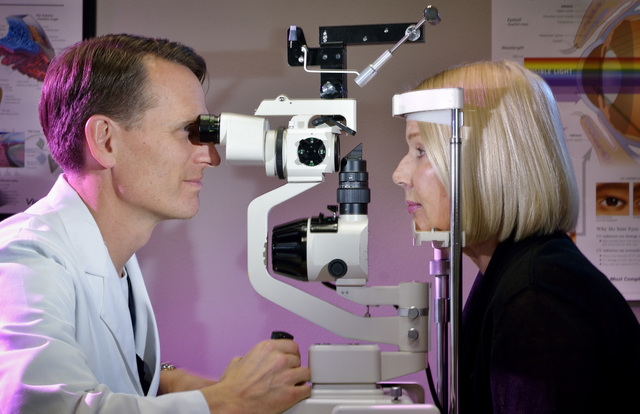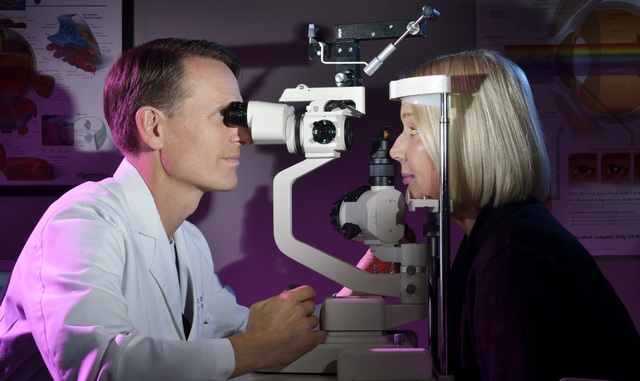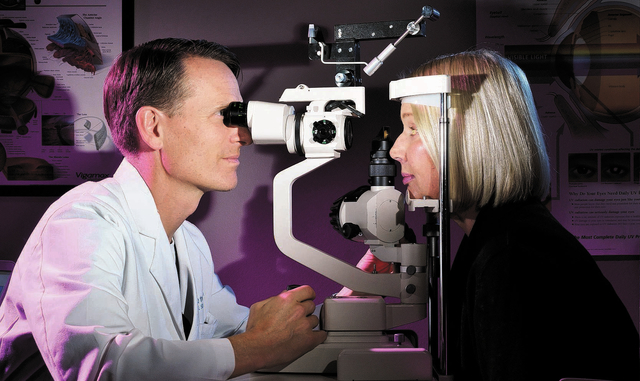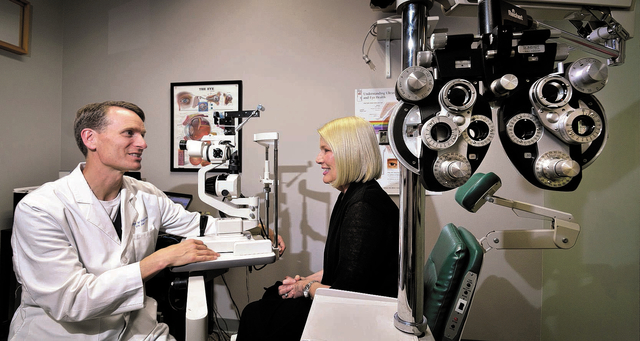Half of those with glaucoma don’t know they have it





Patti Bailey has vivid memories of last summer’s July Fourth weekend. While most of America was warming up the backyard barbecue, Bailey was having a health crisis.
“When I got up, I was almost blind in my right eye,” she said.
The Las Vegas native is no stranger to eye problems. She’s been battling glaucoma for a decade, but this was different. And she knew a holiday weekend was no time to have a medical problem.
She called her ophthalmologist, Dr. Peter DeBry, and got his answering service. The doctor was out of state but his service connected Bailey with his cellphone. DeBry quickly recognized what had happened. It was a retina problem that needed urgent intervention.
DeBry made a call. Two hours later, Bailey was being examined by Dr. Russell Jayne, a retina specialist. The next day, she was in surgery.
“They saved my vision,” Bailey said. “It’s clear as that.”
Today her vision is a manageable 20/30, she said. But the journey hasn’t been easy.
She’s been through so many surgeries she’s lost count — “seven or eight, I think,” she said.
Bailey doesn’t want anyone else to travel that road, so she’s quick to make the case for getting an eye exam before there’s a problem.
“They call glaucoma the silent thief of sight because there are no symptoms,” she said.
She recalled the day she visited a specialist at the University of Southern California for treatment of uveitis, an inflammation of the middle layer of the eye. The doctor performed a tonometry exam, a test that measures the pressure inside the eye. Normal readings are in the range of 12-13; she scored a 55.
The doctor’s advice was to get back to Las Vegas and run, don’t walk, to an ophthalmologist to start treatment for glaucoma.
She found DeBry and has been through a progression of care, from prescription eye drops to surgeries installing shunts to relieve pressure on the optic nerve.
Through it all, she’s stayed upbeat and relied on DeBry. “He has wings on his shoulders,” she said.
The American Academy of Ophthalmology estimates glaucoma affects 2.7 million Americans age 40 and older. The problem is half of them don’t know it yet.
“The challenge with treating glaucoma is helping patients to realize that their vision is at risk although they have no noticeable changes right now,” said DeBry. “Once those symptoms develop, it is too late.”
Glaucoma is highly treatable, noted Dr. Jeffrey Austin, an optometrist with three offices in the Las Vegas Valley.
Optometrists often are the front line of eye care, performing exams, prescribing corrective lenses and spotting problems that require medical intervention.
They can prescribe eye drops that in many cases successfully lower pressure within the eye.
But if that doesn’t work, it’s time to get the patient to an ophthalmologist, a category of medical doctor with advanced diagnostic and surgical skills to deal with eye problems.
Austin estimates there are more than 100 optometrists in the Las Vegas area, half as many ophthalmologists and only a handful of glaucoma specialists.
That’s where DeBry comes in. He’s a graduate of the University of Utah Medical School and did an eye surgery fellowship at the prestigious Bascom-Palmer Eye Institute in Miami. He’s been in practice in the valley for more than a decade, specializing in glaucoma and cataract surgery. He maintains offices in Henderson and on West Sahara Avenue.
Although glaucoma affects mostly older patients, Austin and DeBry agree the best practice is a thorough eye exam annually starting at age 40.
An exam will include a painless tonometry exam in which a puff of air is use to measure pressure inside the eye. Eyes will also be dilated with drops so that doctors can take a closer look at the back of the eye, including blood vessels.
There is no cure for glaucoma — yet. One of the high-profile research efforts — the Catalyst for a Cure Biomarker Initiative — is being funded by the Glaucoma Research Foundation. It is a collaborative research effort designed to accelerate the pace of discovery toward better treatments and a cure for glaucoma.
A diagnosis of glaucoma is not a sentence to blindness, DeBry said.
The Glaucoma Research Foundation estimates that 10 percent of those who are properly treated suffer loss of vision. For the other 90 percent — including Bailey — treatment can slow or halt the condition and preserve sight.
DeBry ticked off a few types of glaucoma, from the most common open angle to the angle-closure type that can be painful, from congenital conditions to normal pressure glaucoma.
Everyone is at risk. One in every 10,000 babies born in the U.S. has congenital glaucoma, the foundation said. And the odds go up with age. Certain groups are at higher risk: those with a family history of glaucoma, blacks, those with diabetes and steroid users, including those taking some prescription asthma drugs.
Left untreated, glaucoma can slowly rob sight. It often starts as a loss of peripheral vision that may be so subtle that the unsuspecting person automatically compensates by turning the head farther to see. Over time, the loss of vision becomes obvious and by then the disease has done serious damage.
At that point, DeBry is ready with a variety of surgical options.
One early intervention involves using a laser to clear the natural drainage channels within the eye. That can reduce pressure on the optic nerve that channels images to the brain. He is also able to perform conventional surgery to open the eye’s natural drainage system. He can create new, artificial drains as well.
“While we have many advanced surgical techniques available, the best course is to diagnose and treat glaucoma early,” DeBry said.
And that starts with scheduling a routine eye exam.


















